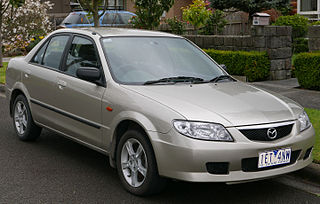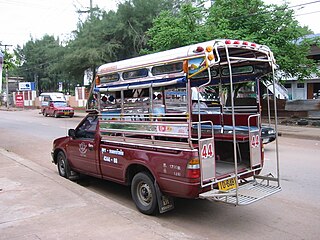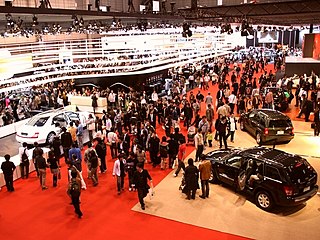
Mazda Motor Corporation, commonly referred to as simply Mazda, is a Japanese multinational automotive manufacturer headquartered in Fuchū, Hiroshima, Japan.

Minivan is a North American car classification for vehicles designed to transport passengers in the rear seating row(s), with reconfigurable seats in two or three rows. The equivalent classification in Europe is MPV . Minivans often have a 'one-box' or 'two-box' body configuration, a higher roof, a flat floor, sliding doors for rear passengers, and high H-point seating. Minivan was also equivalent in Southeast Asia as the Asian Utility Vehicle (AUV).

The Mazda Familia, also marketed prominently as the Mazda 323, Mazda Protegé and Mazda Allegro, is a small family car that was manufactured by Mazda between 1963 and 2003. The Familia line was replaced by the Mazda3/Axela for 2004.

The Mazda Bongo, also known as Mazda E-Series and the Ford Econovan, is a cabover van and pickup truck manufactured by the Japanese automobile manufacturer Mazda since 1966. The Bongo name was also used for the Bongo Friendee, which is not a cabover design.

The Nissan Sunny is an automobile built by the Japanese automaker Nissan from 1966 to 2006. In the early 1980s, the brand changed from Datsun to Nissan in line with other models by the company. Although production of the Sunny in Japan ended in 2006, the name remains in use in China and GCC countries for a rebadged version of the Nissan Almera.

Autozam was a marque of Japanese automaker Mazda, specializing in small cars and Kei cars, many of which were rebadged Suzuki models. Autozam also briefly acted as importer of Lancia vehicles to Japan.
Canadian Car of the Year winners, as chosen by the Automobile Journalists Association of Canada:

The Nissan AD is a subcompact van and wagon built by Nissan since 1982. The AD is sold under a different name when manufactured as a passenger car, called the Nissan Wingroad.

The Chicago Auto Show is held annually in February at Chicago's McCormick Place convention center. It is the largest auto show in North America.

A songthaew is a passenger vehicle in Thailand and Laos adapted from a pick-up or a larger truck and used as a share taxi or bus.

The Nissan Cedric is a large automobile produced by Nissan since 1960. It was developed to provide upscale transportation, competing with the Prince Skyline and Gloria which were later merged into the Nissan family. In later years, the Nissan Skyline was positioned as a sports sedan/coupe, whereas the Nissan Gloria was turned into a sporty version of the Cedric.

The Tokyo Motor Show (東京モーターショー) is a biennial auto show held in October–November at the Tokyo Big Sight, Tokyo, Japan for cars, motorcycles and commercial vehicles. Hosted by the Japan Automobile Manufacturers Association (JAMA), it is a recognized international show by the Organisation Internationale des Constructeurs d'Automobiles, and normally sees more concept cars than actual production car introductions which is the reason why the auto press see the show as one of the motorshow's big five.

The Toyota Probox is a 5-door, 2 or 4-seater passenger car and light commercial van produced by the Japanese automaker Toyota since July 2002. It replaced the Corolla/Sprinter van and served as a slightly shorter version of the now-discontinued Toyota Succeed.

The Nissan Lafesta is a compact MPV built by Nissan mainly for the Japanese market.

The Mazda Grand Familia is an automobile which was produced by Mazda in Japan from 1971 to 1978. It was sold as the Mazda 808 in some export markets including Asia, Australia, and New Zealand, and as the Mazda 818 in many others - this was mostly due to Peugeot having trademarked three-digit numbers with a middle zero in many markets. The body style configurations offered were a two-door coupé, a four-door sedan, and a five-door station wagon. The Grand Familia offered only inline four cylinder engines. The largely identical rotary-powered versions were marketed as the Mazda Savanna in Japan, with export markets taking this model as the Mazda RX-3.

Hidden headlamps, also commonly known as pop-up headlamps, pop-up headlights, flip-eye headlamps, or hideaway headlights, are a form of automotive lighting and an automotive styling feature that conceals an automobile's headlamps when they are not in use.


















